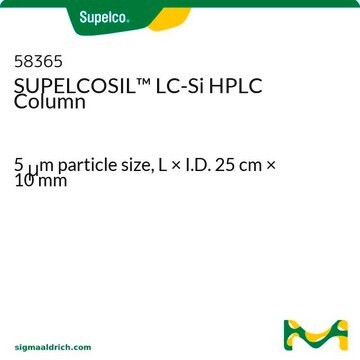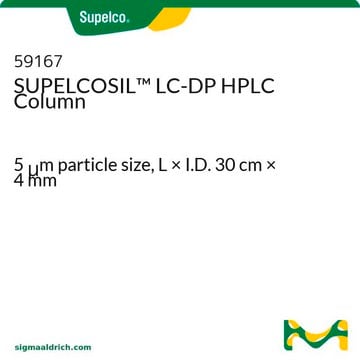Transportation information can be found in Section 14 of the product's (M)SDS.To access the shipping information for this material, use the link on the product detail page for the product.
Kluczowe dokumenty
50284-U
Ascentis® Express 90 Å HILIC (5 μm) HPLC Columns
L × I.D. 5 cm × 4.6 mm, HPLC Column
Wybierz wielkość
2280,00 zł
Wybierz wielkość
About This Item
2280,00 zł
Polecane produkty
Nazwa produktu
Ascentis® Express HILIC, 5 μm HPLC Column, 5 μm particle size, L × I.D. 5 cm × 4.6 mm
Materiały
stainless steel column
Poziom jakości
agency
suitable for USP L3
linia produktu
Ascentis®
Właściwości
endcapped: no
producent / nazwa handlowa
Ascentis®
opakowanie
1 ea of
Parametry
60 °C temp. range
600 bar max. pressure (9000 psi)
metody
HPLC: suitable
LC/MS: suitable
dł. × śr. wewn.
5 cm × 4.6 mm
powierzchnia
90 m2/g
zanieczyszczenia
<5 ppm metals
Matryca
Fused-Core particle platform
superficially porous particle
grupa aktywna macierzy
silica phase
wielkość cząstki
5 μm
wielkość porów
90 Å pore size
pH robocze
1-8
Zastosowanie
food and beverages
metoda separacji
hydrophilic interaction (HILIC)
normal phase
Szukasz podobnych produktów? Odwiedź Przewodnik dotyczący porównywania produktów
Opis ogólny
Charakterystyka kolumny
Cząstki Fused-Core mają powierzchnię ~ 100m2/g i średni rozmiar porów 90Å. Cząstki Fused-Core są od 30% do 50% cięższe niż dostępne na rynku całkowicie porowate cząstki ze względu na gęstość stałych rdzeni. Dlatego efektywna powierzchnia na kolumnę jest podobna do kolumn wypełnionych całkowicie porowatymi cząstkami o powierzchni w zakresie 160-200m2/g.
Informacje prawne
Kod klasy składowania
11 - Combustible Solids
Klasa zagrożenia wodnego (WGK)
WGK 3
Temperatura zapłonu (°F)
Not applicable
Temperatura zapłonu (°C)
Not applicable
Wybierz jedną z najnowszych wersji:
Certyfikaty analizy (CoA)
Nie widzisz odpowiedniej wersji?
Jeśli potrzebujesz konkretnej wersji, możesz wyszukać konkretny certyfikat według numeru partii lub serii.
Masz już ten produkt?
Dokumenty związane z niedawno zakupionymi produktami zostały zamieszczone w Bibliotece dokumentów.
-
What is the Department of Transportation shipping information for this product?
1 answer-
Helpful?
-
-
When referring to the pH of the mobile phase (pH 3, pH 4, etc.), does that refer to the aqueous part of the mobile phase?
1 answer-
Typically when we refer to pH in HILIC, we use the effective pH or the pH as measured after the addition of organic. The point is that we should always define what pH we are stating. The common way to distinguish is using notation of w/w pH or s/w pH (usually superscript/subscript). The notations mean superscript = solvent the pH is measured in (s would indicate some mixture of aqueous:organic) and the subscript = the solvent the pH meter is calibrated in (typically water (or w) as we readily have calibration standards).
Helpful?
-
-
Would you advise addition of a buffer when using diol or amide stationary phase?
1 answer-
Yes. if possible you should always have at least a small amount of buffer in a HILIC system to help mediate/control IEX and other polar interactions that are bound to be present (even if at a low level). It is not so much the "buffering capacity" that is important, but the presence of the competing ions. We have found that their presence helps with day to day and column to column reproducibility. There are times when you need to eliminate the buffer, but aside from special circumstances, our recommendation is to include them.
Helpful?
-
-
How does the flow rate influence the water layer on the column?
1 answer-
We are not aware of any systematic studies with respect to the impact of flow rate on HILIC separations. Our concern would be that as you move to higher flow rates, you might observe peak shape issues due to the slow kinetics of IEX and adsorption mechanisms. If the retention mechanisms for a given system are partition dominated, this should be of less concern. It will be a case by case cause and effect.
Helpful?
-
-
What steps should be taken to maximize column life?
1 answer-
To maximize column life, ensure that samples and mobile phases are particle-free. The use of guard columns or an in-line filter with 0.5 μm porosity between the sample injector and the column is highly recommended. The 2 μm porosity frits on Ascentis Express 5 μm HILIC columns are less subject to pluggage than are the 0.5 μm frits typically used with other small-particle columns. Should the operating pressure of the column suddenly increase beyond normal levels, reversing the flow direction of the column may be attempted to remove debris on the inlet frit.
Helpful?
-
-
What column do you recommend for an anionic compound?
1 answer-
If the acids are hydrophilic or you can adjust the pH to make them hydrophilic enough, any of the phases that exhibit HILIC partitioning are possible (bare silica, OH5, diol, Zwitterionic, amide). We typically go with the OH5 first to try and avoid any negative impacts on the like charge.
Helpful?
-
-
Can peptide or protein samples be analyzed using HILIC columns?
1 answer-
Polar peptides are quite amenable to HILIC separations; however, our experience with larger peptides has been only minimally successful - mainly due to solubility issues. Proteins are even more difficult due to the same issue. An additional problem with proteins is that they are often multiply charged. When IEX is performed on multiply charged analytes, you often get what is referred to as a rolling effect where the analyte interacts with ionic sites on the surface in many different ways as it 'rolls' down the column; this produces broad and misshapen peaks.
Helpful?
-
-
In HILIC separations, what happens if the sample is an aqueous matrix? Does it always have a negative effect?
1 answer-
Yes, it would be highly preferential (especially in this case where you want partitioning to dominate) to inject in high organic. That said, you can 'get away' with it if the injection volume can be kept small - much like we can inject low volumes of stronger solvents in RP mode, if needed. What you will want to do to minimize impact is to get as much retention on the analytes of interest as you can, this helps give the sample solvent some time to dissipate and negate the effects.
Helpful?
-
-
How should I store the Ascentis Express HILIC column?
1 answer-
Long-term storage of silica-based columns is best in 100% acetonitrile. Columns may be safely stored for short periods (up to 3 or 4 days) in most common mobile phases. However, when using buffers, it is best to remove the salts to protect both the column and the HPLC equipment by first flushing the column with the same mobile phase without the buffer (e.g., when using 90/10 ACN/buffer, flush the column with 90/10 ACN/H2O) to eliminate any concern about salt precipitation or corrosion from the salts then flush the column with 100% acetonitrile for storage.Before storing the column, the end-fittings should be tightly sealed with the endplugs that came with the column to prevent the packing from drying.
Helpful?
-
-
When you recommend only changing one parameter at a time, does this also refer to the total ionic strength?
1 answer-
If you change organic, try to keep the overall buffer concentration (and all other parameters, for that matter) constant. There are times when you will want to change both and perhaps pH/temp/etc. simultaneously, but that drastically complicates the system and thus should be avoided, if possible.
Helpful?
-
Active Filters
Nasz zespół naukowców ma doświadczenie we wszystkich obszarach badań, w tym w naukach przyrodniczych, materiałoznawstwie, syntezie chemicznej, chromatografii, analityce i wielu innych dziedzinach.
Skontaktuj się z zespołem ds. pomocy technicznej








